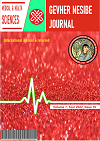Comparison of the Effects of Inhalation and Spinal Anesthesia on Microcirculation in Transverse Rectus Abdominis and Gluteus Maximus Muscle-Skin Flap Applications in Experimental Rat Models
DOI:
https://doi.org/10.46648/gnj.323Keywords:
inhalation, spinal, anesthesia, muscle-skin flapAbstract
Background: Alongside developments in the surgical approaches to flap dissections, significant advances have been seen also in anesthetic techniques, as one of the main factors in the performance of such interventions. Literature contains several clinical studies aiming to determine the optimum anesthetic technique for use in flap and microsurgical procedures, however there is still a lack of consensus on the ideal anesthetic technique. The present study compares experimentally the effects of inhalation and spinal anesthesia on different muscle-skin flaps during flap surgery. Methods: The study assigned 35 rats to five groups: Group 1) a control group with no ischemia induced; Group 2) undergoing an elevated transverse rectus abdominis muscle-skin flap under inhalation anesthesia; Group 3) undergoing an elevated transvers rectus abdominis muscle-skin flap under spinal anesthesia; Group 4) undergoing an elevated gluteus maximus muscle-skin flap under inhalation anesthesia; and Group 5) undergoing an elevated gluteus maximus muscle-skin flap under spinal anesthesia. After the experiment, the malondialdehyde, total antioxidant capacity and total oxidative stress values were measured. Specimens were taken for histopathological examination to assess hyalinization, inflammation, congestion, edema, hemorrhage, nuclear centralization, and fibrotic areas. Results: Inflammation, congestion and edema were significantly higher in Groups 2 and 4 than in the other groups. Conclusion: In the light of the study findings, it can be concluded that regional anesthesia is the preferable anesthetic method in flap procedures, since inhalation anesthesia has an oxidative effect on both transvers rectus abdominis and gluteus maximus muscle-flap models, while such effects are lower with spinal anesthesia.
Downloads
Published
How to Cite
Issue
Section
License

This work is licensed under a Creative Commons Attribution-NonCommercial 4.0 International License.


